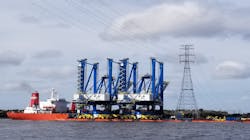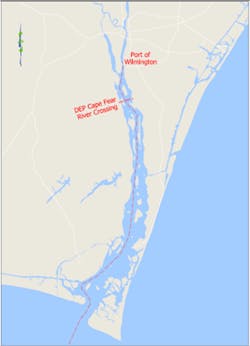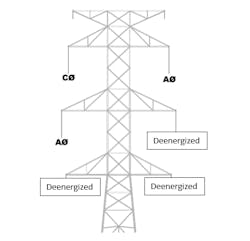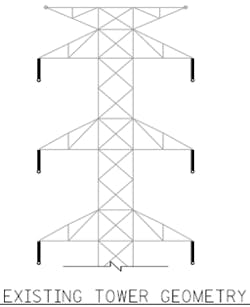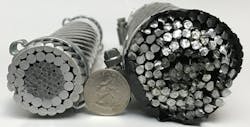A Tall Order: Duke Energy’s North Carolina State Ports Authority Project
Cargo ship sizes are literally reaching new heights. The expansion of the Panama Canal in 2016 allowed for larger vessels to call ports in the United States. These larger vessels, classified as Neo-Panamax, stimulated a flurry of upgrades to ports in the Americas to accommodate the Neo-Panamax vessels. This included the North Carolina State Ports Authority’s (NCSPA) $200 million capital investment plan for the Port of Wilmington.
The NCSPA also requested Duke Energy to increase the air draft at a double-circuit 230kV transmission line crossing that was downstream from the Port. Increased air-draft would first be required for the delivery of new larger cranes to be installed at the Port and ultimately allow for the safe passage of the New-Panamax vessels themselves.
Duke Energy’s 230kV double circuit transmission crossing was constructed in 1972 and consists of three spans totaling 6,080 ft .(1,853.18 m) in length. There are two 335-ft. (102.1 m) tall steel lattice structures located in the river on each side of the shipping channel. The channel crossing span is approximately 2,000 ft. (609.6 m). The three spans are anchored on each bank of the river by 115-ft. (35.05 m) tall, guyed, lattice structures. The 1972 installation provided for 165 ft. (50.29 m) of air draft above mean high water (MHW).
Not Without Challenges
The Port’s request to raise the line crossing for the crane delivery and the Neo-Panamax vessels was not without challenges. The cranes were to be delivered the following year, providing little time. The channel was also on a busy waterway that commerce depended upon. Therefore, the channel needed to remain open as much as possible. Additionally, both crossing circuits connect to the nearby Brunswick Nuclear Plant. Thus, at least one of the two circuits had to remain energized. Last, but not least, the crossing is situated in the environmentally sensitive Cape Fear estuary. Taking all this into account, the project team set out to devise a plan that accommodated the Port’s clearance needs while also considering the associated cost.
One Thing at a Time
The cranes were to be delivered the following year. Raising the double circuit lines by this time seemed like an impossible task. Undaunted, the team decided to focus on the issue at hand. The team set forth to determine exactly how much additional clearance was needed for the rapidly approaching crane delivery. A scaled drawing was developed that integrated the position of the cranes on the transport vessel relative to the transmission line conductors. Then, an as-built PLS-CADD model was developed based on a LiDAR (Light Detection and Ranging) survey, finite-element wire model, and data from various sources, including the Army Corps of Engineers.
Using the model, the project team determined that 12 ft. (3.66 m) of additional clearance was required. Conventional ground surveys were used to validate the determination. Additionally, the team went as far as to survey the actual height of the cranes before they left their port of origin in China.
The team devised a plan to reconfigure the circuits so that the top phase wire on each side along with one of the middle phase wires would comprise one circuit rather than having a circuit on each side of crossings towers. This would allow for the bottom conductors to be deenergized. Once deenergized, the bottom conductors could be detached from their insulators, hoisted up and attached directly to the tower arm. The hoists would be attached to the middle arms above.
However, many other events had to take place before the plan to temporarily raise the conductor could be implemented. First, the condition of the existing structures was evaluated. This included developing a tower climbing plan and then physically climbing the towers for visual inspection. A dive team was also deployed to inspect the foundations in the river.
On to the Permanent Solution
After the cranes were delivered, the wires were returned to their typical configuration. Now, the team turned their focus on finding a long-lasting solution that increased the air draft at the line crossing enough to allow for Neo-Panamax vessels to begin calling the Port. The team evaluated numerous options, including various modifications to the existing line, building a totally new overhead line, and even putting it underground. Each potential solution was scored based on environmental impact, time, schedule, and the long-term reliability and resiliency.
Once the tower members and arms had been evaluated and designed, they were fabricated in Texas. One of the arms was assembled at the steel manufacturer’s facility and the team traveled to the facility to evaluate the fit-up. A replica of the middle portion of the crossing towers where the new arms would attach was also assembled so the fit-up between the new arms and existing tower body could be checked. Minor adjustments were noted that included adjusting some of the connections to ensure working room for tightening bolts.
Construction began in August 2019. Through the course of construction, twelve channel closures were required, each closure consisting of three days. The construction team faced many challenges including Hurricane Dorian passing through the area in September 2019, as well as record temperatures. A record-high temperature was experienced (or endured) in October 2019 as well as record low temperatures in November 2019. The team took it all in stride and construction was completed in January 2020.
Historic Achievement
History was made on May 20, 2020, when the MV Hyundai Hope with an air draft of 204 feet crossed below the newly raised Cape Fear River transmission crossing; the ship is one of the largest container ships calling on the United States East Coast and was the largest to ever dock in North Carolina, according to a 2020 article of Wilmington Business Development. The Port’s ability to service the Neo-Panamax vessels like the MV Hyundai Hope will provide lasting economic benefits to the state of North Carolina.
In summary, the project team added a total of approximately 41 ft. (12.50 m) of additional clearance. The reframing provided 28 ft. (8.53 m) of extra clearance and the new low sag conductor provided over 13 ft. (3.96 m) of additional clearance. The line switches and jumpers that were installed on each side of the crossing during the temporary solution will continue to remain in place to provide flexibility to adjust which phases are energized for future maintenance.
The final solution had three main benefits: 1) it was preferred from a cost and environmental impacts perspective, 2) it met the port authority’s timeline and clearance needs, and 3) improved future reliability for customers in the area.
E.J. Benton, PE, ([email protected]) director of engineering, has over 15 years of experience in the transmission & distribution industry. Currently, he leads power delivery engineering teams at Pickett and Associates. He has led project teams tasked with T&D engineering up to 765kV with project locations throughout North America. Benton received his bachelor’s degree in civil engineering from the University of South Florida and his MBA from the University of Florida. He is a licensed professional engineer in eight states.
John Taylor, PE ([email protected]), transmission R&PM senior project manager, has been employed by Duke Energy his whole professional career. Taylor worked in multiple positions within System Operations for the first nine years and has been in a variety of Transmission Resource & Project Management (R&PM) roles since 2011. He is currently sr. project manager in the Development & Estimating organization. John enjoys leading cross-functional teams to collaborate and develop effective, customer-focused solutions.
Ben Wadsworth, PE, ([email protected]), manager of engineering, has over seven years of experience in the transmission and distribution industry, currently serving as manager of Engineering out of Pickett and Associates’ Raleigh office. He has over 14 years of structural engineering experience and has performed bridge design for seven years prior to beginning a career in T&D. Wadsworth graduated Magna Cum Laude from the University of South Florida with a Bachelor of Science in Civil Engineering.
Ganga Pontula, PE, ([email protected]) is a senior consultant and supervisor at Gannett Fleming with over 20 years of experience in the power industry and is a licensed engineer of North Carolina. Specializing in the design of electrical transmission lines and its components in various challenging conditions, his experience includes generation planning and corporate strategic analysis. He received his master’s degrees in mechanical engineering from Purdue University and
in transmission and distribution engineering from Gonzaga University.
About the Author
John Taylor
John Taylor, PE, PMP – Transmission R&PM Senior Project Manager has been employed by Duke Energy his whole professional career. John worked in multiple positions within System Operations for the first 9 years and has been in a variety of Transmission Resource & Project Management (R&PM) roles since 2011. He is currently Sr. Project Manager in the Development & Estimating organization. John enjoys leading cross-functional teams to collaborate and develop effective, customer-focused solutions.
Ganga Pontula
Ganga Pontula, PE – Senior Consultant and Supervisor, a is a senior consultant and supervisor at Gannett Fleming with over 20 years of experience in the power industry and is a licensed engineer of North Carolina. Specializing in the design of electrical transmission lines and its components in various challenging conditions, his experience includes generation planning and corporate strategic analysis. He received his master’s degrees in mechanical engineering from Purdue University and in Transmission and Distribution Engineering from Gonzaga University.
E.J. Benton
E.J. Benton, PE, MBA – Director of Engineering has over 15 years of experience in the transmission & distribution industry. Currently, he leads power delivery engineering teams at Pickett and Associates. He has led project teams tasked with T&D engineering up to 765kV with project locations throughout North America. Mr. Benton received his bachelor’s degree in civil engineering from the University of South Florida and his MBA from the University of Florida. He is a licensed professional engineer in eight states.
Ben Wadsworth
Ben Wadsworth, PE, LEED AP – Manager of Engineering, has over 7 years of experience in the transmission and distribution industry, currently serving as Manager of Engineering out of Pickett and Associates’ Raleigh office. He has over 14 years of structural engineering experience and has performed bridge design for 7 years prior to beginning a career in T&D. Mr. Wadsworth graduated Magna Cum Laude from the University of South Florida with a Bachelor of Science in Civil Engineering.
